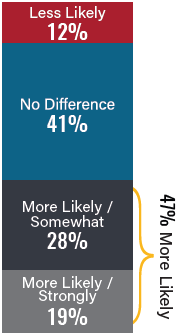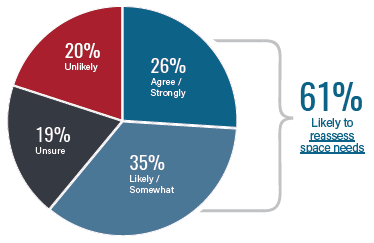THE OFFICE WORKS
There’s no doubt about the future of the office. Nearly three-quarters
of surveyed tenants—and 77 percent of C-suite
executives and business owners—report that the office is vital
to conducting a successful operation.
Building managers also get high marks, with 78 percent of
respondents approving or strongly approving of how their
building teams responded to the health crisis. Contributing to
that score were their communications methods—with 79 percent
saying landlords reached out “just the right amount.” And,
clearly, the communications needn’t be elaborate or costly for
building managers to score a big win. The method of choice
was email, favored by 63 percent of tenants, with some sort of strategy guide and in-building signage coming in second and
third. Lower down on the list of preferred outreach methods
were quarterly video calls with building managers, as well
as prerecorded videos and webinars or “town halls,” none of
which were capital-intensive solutions. Those high marks
move directly to the bottom line, and 47 percent of respondents
say that, based solely on building managers’ responses
to COVID-19, lease renewals are somewhat or very likely.
By comparison, pre-COVID, 55 percent of surveyed tenants
would renew if their building teams focused on communications;
investments in advanced processes and technologies;
and, on the softer side, relationships (46 percent see more
value in a personal relationship with their property managers).
That score jumped to 66 percent post-pandemic.
MORE WORK LEFT TO DO
At 66 percent, renewals are clearly not a slam-dunk, and nearly
as many tenants—61 percent to be exact—plan on some
reassessment of their space needs. And, of those, 54 percent
either are planning to cut back on their square footage or are
unsure. Thirty-three percent would either expand their spaces
or stay put.
If (or when) space users make their cuts, where will they
happen? The winner—or loser in this case—was common areas,
voted by 36 percent of respondents. It was also the number
one choice of all occupants when segmented by the size of
their holdings. Drilling down more, tenants suffering low 2020
revenues outweighed their high-revenue counterparts in their
eagerness to cut common areas (43 percent of lower-revenue
responses compared to 30 percent of higher-revenue firms).
Reducing the size of private offices came second at 28
percent and reducing the number of private offices placed
third at 27 percent. Rounding out the top five, a reduction in
conference room size was selected by 27 percent. Only then do
we start to see changes in working protocols, with 25 percent
of respondents eyeing adoption of hoteling or flexible work
desks for teleworkers. It should be noted that, in this age of
high single-digit unemployment, a relatively low 23 percent
of respondents are considering cutting their workforce. Not
surprisingly, most of these are lower-revenue firms.
Impact on Renewal

Q: Have your property manager or landlord's responses
to COVID-19 made you more likely to renew your lease?
What’s driving these space decisions? Also not surprisingly,
cost (34 percent); location and proximity to clients, customers
and employees (31 percent); and safety and security (25
percent). These three rank the highest (or second highest) by
tenants responding to the survey.
Herein too reside opportunities for building managers to
enhance their relationships and, possibly, their renewal rates.
Homing in on tenant needs for space cuts, working with them
to develop solutions and communicating to them your safety
and security strategies all send a clear message of proactivity
on their behalf.
There’s a fairly tight cluster of responses around new protocols
occupants plan to put in place, whether or not they’re reassessing
their space needs. In the low-hanging-fruit category,
80 percent of respondents plan to enforce the universal use of
face masks. Seventy-four percent will enforce occupancy limits
in common areas, and 65 percent plan a staggered return-to-work schedule.
MAKING SENSE WITH THEIR DOLLARS
With cost concerns high on tenant radars, how much of an
impact would those space cuts have on their bottom line?
Forty-seven percent envision increases, while 35 percent
would still suffer revenue losses. Eighteen percent expect no
change in their revenues, 24 percent of whom are tenants of
1,000 to 5,000 square feet. As a generalized statement, more
larger space users tended to reap revenue improvements as a
result of their post-COVID cutbacks than smaller firms.
In terms of the perceived value that certain building-provided
protocols and products could bring, the survey highlighted
five and linked to them the number of tenants who would
pay a premium for them. The Big Five (in descending order
of rank) were: maximized fresh air (37 percent); the installation
of large and prominent disinfection stations (21 percent);
twice-daily full sanitization with chemicals and ultraviolet treatment (17 percent); additional front-desk staffing to ensure
safety policies (13 percent); and an on-site health and wellness
advisor (11 percent). No fewer than 33 percent of respondents
checked the “would pay a premium” box in any of those five
categories. The top-rated fresh air/heating, ventilating and air-conditioning
(HVAC) concern ranked highest in the premium
question, at 47 percent of respondents.

Q: How likely are you to reassess your space needs based on business impacts from the coronavirus?
It’s interesting to note that 49 percent also indicated their
interest in more flexible, shorter lease terms, while 42 percent
desired longer terms with clauses that speak to health.
Of those who are reassessing their spaces, there are a few
other areas, either paid for or complimentary, where building
managers could pitch in (presumably with the previously mentioned
benefits to renewals). These are access to vacant spaces
for social-distancing purposes (71 percent); building out dedicated
teleworking rooms and office relocation services (52 percent);
and providing relocation services (62 percent). However, the
perceived level of employee comfort provided by each of these
provisions never ranked below 50 percent.
THE VALUE PROPOSITION
Arguably, it is here that the light property managers bring to the
chaos of COVID-19 shines most brightly. When asked about the
investments property owners and managers are making in the
physical features and infrastructures of their assets in the name
of tenant safety, the score is a fair 65 percent, but with about 35
percent of respondents holding off, either unsure (27 percent)
or seeing no value (8 percent). What’s more, 62 percent of office
tenant respondents recognize the importance of their physical
environments for facilitating the human connections that contribute
to productivity and then, by extension, the most successful
businesses.
As BOMA International continues to unpack the results of the study, both on a
national and regional basis, it becomes clear that property managers
have more work to do to close the gap in tenant relationships.
But, it is equally clear that the most proactive building
professionals are taking the lead in the items they can control,
communicating their concern and involvement in the health, safety
and productivity of their tenants.
About the Author: John Salustri is editor-in-chief of
Salustri Content Solutions, a national editorial advisory firm based
in East Northport, New York.